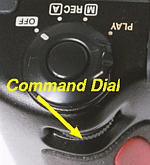 |
 |
| The QUAL Button | The Command Dial |
Image quality and image size determine the number of photographs that can be stored on a memory card. The following table shows the available combinations of image quality and image size for a 8mb memory card.
| Image Size | Quality | No. of Images on a 8MB Card |
| Full (1600×1200) | BASIC | 32 |
| NORMAL | 16 | |
| FINE | 8 | |
| HI (M-REC only) | 1 | |
| XGA (1024×768) | BASIC | 78 |
| NORMAL | 39 | |
| FINE | 19 | |
| VGA (640×480) | BASIC | 200 |
| NORMAL | 100 | |
| FINE | 50 |
The BASIC (high compression), NORMAL (medium compression), and FINE (low compression) settings use JPEG compression to reduce the amount of required memory and can cause loss in quality slightly. The NORMAL setting is the default, and, as a result, 16 photographs can be stored on a 8mb card. If you prefer to have finer resolution photographs, use the FINE setting; however, the number of photographs stored on a card is reduced by 50%. In many cases where resolution is not so important (i.e., images to be post on your web pages), the BASIC setting works fine. However, the image size must be factored in. For web applications, 640×480 is good enough; while to print a 8"×10" photograph, you perhaps need the highest resolution 1600×1200.
The HI setting can only be used in the M-REC mode. The image will be saved in uncompressed TIFF format and has no loss in quality. However, a 8mb card can only store photograph!
To set a combination of image quality and image size, hold the QUAL button and at the same time turn the command dial (see the figure below). Note that this can only be used in the A-REC mode and the M-REC mode. Moreover, the HI setting can only be used in the M-REC mode.
 |
 |
| The QUAL Button | The Command Dial |
As the command dial is being turned, the image size (i.e., XGA and VGA), the image quality (i.e., BASIC, NORMAL, FINE and HI), and the number of photographs that can be stored in the remaining memory of your card are displayed in the lower-right corner of the LCD monitor and on the control panel. Please note that image size FULL is not shown since it is the default.
Let us take a look at the image quality differences. The following is a photo using the FINE mode. Its size is nearly 1.5MB.
| |
| Click on the photo to see a full size (1600×1200) one |
The trunk near the center marked by a yellow rectangle has fine texture which is good for testing image quality. To compare, a photo is taken for each resolution and enlarged to 1600×1200 without sharpening. Then, the size of the indicated area is doubled. The center part of the photo is used because a lens is always sharper in the center than near the corners. As a result, the quality of the lens will not affect the the comparison of image compression. The following is the results.
| |
FINE Low Compression |
NORMAL Medium Compression |
BASIC High Compression |
| Full |
|
|
|
| XGA |
|
|
|
| VGA |
|
|
|
| Click on the photo to see a larger one | |||
It is shown from these photos that the FINE mode provides sharper images than the NORMAL mode, which is in turn has better image quality than the BASIC mode. Similarly, the Full mode is better than the XGA mode, and the XGA mode is better than the VGA. Of course, this loss-of-quality is mainly due to enlargement. Therefore, the image quality should still be very good, even in high compression modes, as long as the image is not enlarged. What we may lose is some details due to fewer pixels used in the image. It is easy to see that a scene recorded with 1600×1200 pixels has 6.25 times more pixels than the same scene recorded with 640×480 pixels. As a result, if image quality is critical, use the FINE mode or even the uncompressed HI mode.